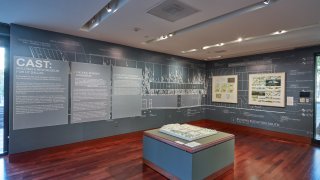
The Crow Museum of Asian Art is introducing the design of its second location with an exhibition in the Dallas Arts District.
The Crow Museum of Asian Art of The University of Texas at Dallas is presenting its expansion as art.
When the Trammell and Margaret Crow family donated the entire collection of the Trammell and Margaret Crow Museum of Asian Art to The University of Texas at Dallas (UT Dallas) in 2019, the donation included $23 million for the design and construction of a second museum on the UT Dallas campus in Richardson. The Crow Museum unveiled the plans for the second museum in an exhibition, “Cast: Molding a New Museum for UT Dallas.” The exhibition is on view at the museum’s Dallas Arts District location through March 5.
The new museum is part of UT Dallas’ Phase 1 of the planned Edith and Peter O’Donnell Jr. Athenaeum, a 12-acre cultural district on the southeast corner of the campus. In addition to showing the design process for the Crow Museum, the exhibition includes the original design conceived by the late Dr. Richard C. Brettell, who initiated plans for the Athenaeum and was integrally involved in the selection of the project’s architecture firm.
Get DFW local news, weather forecasts and entertainment stories to your inbox. Sign up for NBC DFW newsletters.
“What I was hoping for as the curator of the exhibition is to answer the question ‘what is athenaeum?’” said Amy Lewis Hofland, the museum’s Senior Director. “This idea that when culture is presented together, visitors from campus and community both have a greater opportunity to connect, meet each other and learn.”
Modeled on the Dallas Arts District and the Arts District in Fort Worth, the cultural district will include a performance hall, an additional museum building for the future, a 1200-space parking garage and a two-acre plaza acting as connective tissue for the cultural district. The museum is scheduled to open in 2024 and the performance hall will be completed in 2026.
“It will be the first athenaeum in the United States with an art museum with a corpus of Asian art so that’s a really different way to think about these Greek ideas in a global context,” Hofland said.
After a competitive selection process, Morphosis, the Pritzker Prize-winning global architecture and design firm, was chosen for the project. Morphosis has a history with Dallas: the firm designed the Perot Museum of Nature and Science.
The Scene
“What I love about Morphosis is they elevated the galleries to the second level,” Hofland said. “If all the galleries were on the first level, it would be a solid wall at grade. This way, with them lifted, we can offer transparency on the first floor to the lobby, to the Brettell Reading Room which is an important part of the building, so people can see people inside and one of the keys to magnetic building is that you can see people interacting and say, ‘I want to be part of that.’”
The exhibition shows the creation process of the museum’s exterior concrete skin.
“We had to render several samples with different compositions,” Hofland said. “This was poured inside a rubber mold. It is really like what we learned to make a mold in elementary school.”
The white exterior will have a little bit of sparkle and a distinctive pattern.
“I think it will be cool to watch it in the shifting light,” Hofland said.
The architects created dramatic renderings of the interior for the exhibition, featuring the grand staircase and the neutral spaces that will make the art the star of the museum.
“Really what this is showing is the warmth of the lobby,” Hofland said.
With a 35-year lease in the Dallas Arts District, Hofland makes it clear the museum has no plans to leave its downtown home. The new museum in Richardson will double the amount of gallery space the museum has to showcase its collection. Curators will create common threads between the exhibitions at the two locations and onsite storage at the Richardson location will make life easier for the museum.
“We’re not going anywhere,” Hofland said. “What we want is for people to access as much of the collection as possible.”
The exhibition gives a glimpse of future galleries with works from the Stevens, Boeckman and Horchow collections that have been gifted to The University of Texas at Dallas and acknowledges everyone working on the new museum, emphasizing the human beings creating this museum for people to enjoy.
“This is the people’s museum,” Hofland said.
Complementing “Cast” is “Phoenix Rising: Xu Bing and the Art of Resilience,” an exhibition featuring Bronze Phoenix 2016 (Feng and Huang). The two sculptures were created by internationally acclaimed Chinese artist, Xu Bing. The artist used found items out of the rubble of recently demolished buildings to create a male and female phoenix.
“In traditional Chinese folklore, they rise out of the ashes. They are the bird that you think is dead and then it breathes in breath and rises up out of the ashes into this glorious multicolored feathered creature that has all the power of many animals, the talons of the eagle, the lion’s face. It’s all here in this powerful beast,” Hofland said.
The museum is planning on acquiring the sculptures to display in its new museum.
“Thinking about where we’ve been in the last three years and even through the transition of the Crow Museum becoming a university museum, we will rise stronger, more resilient, more beautiful in the future,” Hofland said.
Learn more: Crow Museum